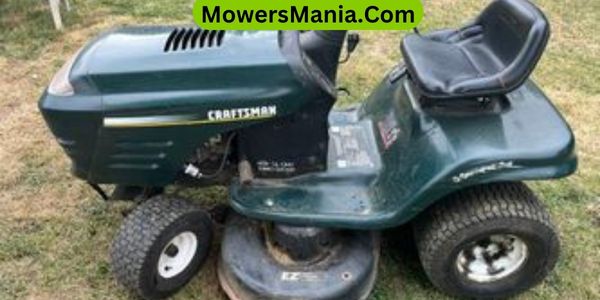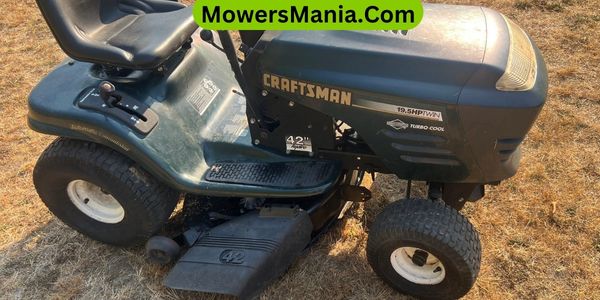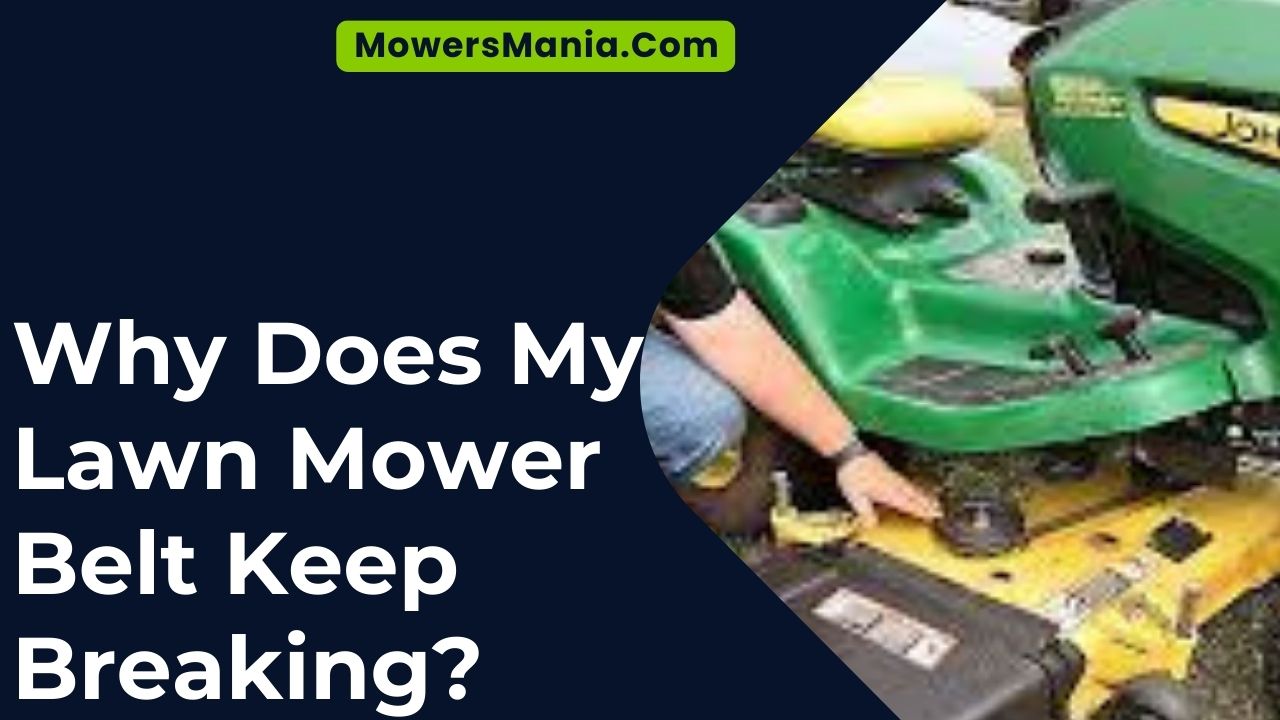Are you tired of constantly replacing your lawn mower belt? It’s like throwing good money after bad. Understanding why your lawn mower belt keeps breaking can save you time, money, and frustration.
There are several common reasons for this recurring problem, and identifying the cause is the first step towards finding a lasting solution.

By addressing issues like improper tension, worn pulleys, or overloading, you can extend the life of your mower belt and enjoy hassle-free lawn care.
Let’s delve into the potential causes and solutions to keep your lawn mower running smoothly.
Improper Belt Tension
You should regularly check and adjust the belt tension to prevent breakage. Incorrect belt tension is a common culprit for frequent belt breakage in lawn mowers.
When the tension is too loose, the belt can slip, causing excessive heat and wear that eventually lead to breakage. On the other hand, if the tension is too tight, it can put unnecessary strain on the belt, also increasing the likelihood of breakage.
To ensure the proper tension, refer to your mower’s manual for specific instructions on how to adjust the tension correctly.
Typically, this involves loosening the bolts that secure the engine to the mower deck, allowing the engine to pivot and create the right amount of tension on the belt. Once adjusted, make sure to tighten the bolts back to secure the engine in place.
Regular maintenance of the belt tension is crucial to keeping your lawn mower running smoothly and preventing the inconvenience and cost of frequent belt replacements. So, take the time to inspect and adjust the tension regularly to avoid unnecessary belt breakages.
Worn or Damaged Pulleys
If your lawn mower belt keeps breaking, worn or damaged pulleys might be the culprit. Uneven wear on the pulleys can cause excessive strain on the belt, leading to breakage.
Additionally, rusty pulleys weaken the belt, making it more prone to snapping during operation.
Uneven Wear Causes Breakage
Excessive wear on the pulleys can cause your lawn mower belt to keep breaking. When the pulleys become worn or damaged, they can create uneven wear on the belt, leading to premature breakage.
The uneven surface of the pulleys can cause the belt to slip, jump, or lose tension, increasing the likelihood of it snapping. Additionally, worn pulley edges can create sharp points that damage the belt over time.
Inspect the pulleys regularly for signs of wear, such as rough surfaces, grooves, or cracks. If you notice any damage, replace the pulleys to ensure smooth and even operation of the belt.
Rusty Pulleys Weaken Belt
Inspect the pulleys regularly for signs of rust or damage to prevent weakening of the lawn mower belt. Rusty or damaged pulleys can cause the belt to slip or break. Rust weakens the metal, leading to rough surfaces that can shred the belt over time.
Additionally, damaged pulleys with dents, cracks, or sharp edges can cause the belt to wear down unevenly, leading to premature failure. When inspecting the pulleys, look for any discoloration, rough patches, or visible damage. If you notice any issues, replace the pulleys promptly to prevent further damage to the belt.
Keeping the pulleys in good condition will help ensure smooth operation and prolong the life of your lawn mower belt.
Overloading the Mower

You may be overloading the mower with dense or wet grass, causing excessive strain on the belt and leading to frequent breakages. When you overload your lawn mower, you put unnecessary stress on the belt, increasing the likelihood of it breaking.
Here are some common ways you might be overloading your mower:
- Mowing too low: Cutting your grass too short can lead to a heavy buildup of clippings, especially if the grass is dense or wet.
- Mowing too fast: Trying to rush through mowing by going too fast can cause the mower to become overloaded with clippings.
- Neglecting maintenance: Failing to clean out the underside of the mower deck regularly can cause grass clippings to accumulate and overload the mower.
- Using a dull blade: A dull mower blade can tear the grass instead of cleanly cutting it, leaving behind jagged edges that can overload the mower with excessive clippings.
Misaligned Components
When operating your mower, ensure that all components are properly aligned and free from obstructions to prevent undue stress on the belt. Misaligned components can cause the belt to slip or wear unevenly, leading to premature breakage.
Check that the pulleys, idlers, and other components are in line with each other according to the manufacturer’s specifications. Even a slight misalignment can put extra strain on the belt, causing it to fail sooner than expected.
In addition to alignment, make sure that all moving parts are functioning smoothly without any interference.
Debris, such as grass clippings or twigs, can get lodged in the pulley system, causing components to shift out of alignment and increasing the likelihood of belt breakage. Regularly inspect and clean the undercarriage and pulley system to prevent debris from causing misalignment and belt damage.
Taking the time to ensure that all components are properly aligned and free from obstructions can significantly extend the life of your mower belt. By addressing misalignment issues promptly, you can prevent the inconvenience and expense of frequent belt replacements.
Low-Quality Belt Material
If your lawn mower belt keeps breaking, one potential reason could be the use of low-quality belt material. Inferior belt material can easily wear out and weaken, leading to more frequent belt failures.
When the belt material lacks durability and strength, it may struggle to withstand the demands of regular lawn mower operation.
Inferior Belt Material
Are you constantly experiencing belt breakages on your lawn mower due to using low-quality material? The inferior belt material could be the root cause of your frustration.
Here’s why:
- Weak Durability: Low-quality belts are more prone to wear and tear, leading to frequent breakages.
- Poor Heat Resistance: Inferior material is less capable of handling the heat generated during mowing, causing the belt to degrade quickly.
- Lack of Flexibility: Low-quality belts may lack the flexibility needed to navigate the intricate machinery of a lawn mower, leading to premature failure.
- Inadequate Traction: Belts made from inferior materials may struggle to maintain proper traction, increasing the risk of slipping and breaking.
Investing in a higher-quality belt made from durable materials can significantly reduce the frequency of breakages and improve the overall performance of your lawn mower.
Belt Material Weakness
Invest in a high-quality belt made from durable materials to avoid the weaknesses associated with low-quality belt materials and prevent frequent breakages on your lawn mower.
Low-quality belt materials are prone to premature wear and tear, leading to frequent breakages. These materials may lack the necessary tensile strength and resistance to heat and friction, causing them to deteriorate quickly.
As a result, the belt becomes susceptible to cracking, stretching, and ultimately snapping during operation.
Furthermore, low-quality materials may not withstand the demands of heavy-duty mowing tasks, further contributing to their weakness.
By opting for a belt constructed from high-quality materials such as Kevlar or reinforced rubber, you can ensure greater durability and resilience, ultimately reducing the likelihood of belt breakages and the associated downtime and maintenance costs.
Lack of Lubrication

Why does your lawn mower belt keep breaking due to lack of lubrication? Lack of proper lubrication can cause unnecessary friction and heat, leading to premature wear and tear on the belt.
Here’s why this happens:
- Increased friction: Without proper lubrication, the belt can experience increased friction against the pulleys and other moving parts, causing excessive strain on the belt material.
- Heat buildup: Friction generated from the lack of lubrication can result in heat buildup along the belt’s surface. This heat weakens the belt material over time, making it more prone to breakage.
- Accelerated wear: The absence of lubrication accelerates the wear and tear process, causing the belt to deteriorate faster than usual and increasing the likelihood of it breaking.
- Reduced flexibility: Lubrication helps maintain the belt’s flexibility, ensuring it can move smoothly and efficiently. Without proper lubrication, the belt becomes stiffer and less able to handle the stress of regular operation.
To prevent these issues, regularly inspect the belt for signs of wear and ensure it’s adequately lubricated to minimize friction and heat buildup.
Frequently Asked Questions [FAQs]
Can Using the Lawn Mower on Wet Grass Contribute to Belt Breakage?
Using the lawn mower on wet grass can contribute to belt breakage. Wet grass creates extra resistance, putting strain on the belt. To prevent this, try to mow when the grass is dry to reduce wear and tear.
How Often Should I Check and Adjust the Belt Tension on My Lawn Mower?
You should check and adjust the belt tension on your lawn mower every 25 hours of use or at the start of each mowing season. Proper tension ensures the belt doesn’t slip or become damaged, helping to prevent breakage.
Are There Specific Types of Lubrication That Work Best for Preventing Belt Breakage?
You should use a dry lubricant on your mower belt, as it prevents buildup and reduces friction. This will help to extend the life of your belt and reduce the risk of it breaking.
Is There a Way to Prevent Overloading the Mower When Cutting Particularly Thick or Tall Grass?
To prevent overloading the mower when cutting thick or tall grass, adjust the mowing height to a higher setting and make multiple passes. Avoid forcing the mower through dense areas. Clear debris regularly to prevent the belt from overworking and breaking.
What Are the Signs That My Pulleys May Be Worn or Damaged and in Need of Replacement?
If your pulleys are worn or damaged, signs may include unusual noises, vibrations, or wobbling. Check for visible wear or cracks. Replace the pulleys if they show signs of damage to prevent further issues with your lawn mower belt.
Conclusion
So, if your lawn mower belt keeps breaking, it’s likely due to:
- Improper tension
- Worn pulleys
- Overloading
- Misalignment
- Low-quality material
- Lack of lubrication
To prevent this, you can take the following steps:
- Regularly check and adjust belt tension
- Inspect and replace worn pulleys
- Avoid overloading the mower
- Ensure proper alignment
- Use high-quality belts
- Lubricate moving parts
By addressing these issues, you can keep your lawn mower belt in good working condition and avoid frequent breakages.



